Sample Question #1
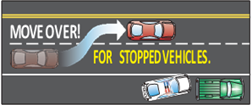 When approaching stopped vehicles:
When approaching stopped vehicles:
A. Remain in your lane of traffic and do not reduce speed.
B. Change lanes so you do not drive next to the stopped vehicle.
C. Reduce your speed by 10 miles per hour under the posted speed limit.
B. Change lanes so you do not drive next to the stopped vehicle.
Class C Driver Manual - Sharing the Road - Approaching Stopped Vehicles (Page 44)
Sample Question #2
This sign means: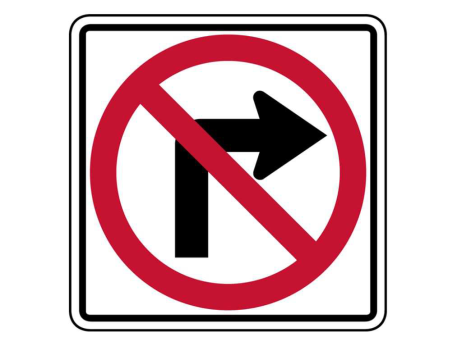
A. A right turn is not allowed.
B. Turns are not allowed.
C. A left turn is not allowed.
A. A right turn is not allowed.
Class C Driver Manual - Signs and Traffic Signals - Regulatory Signs - Prohibitive (Page 7)
Sample Question #3
Oregon's Implied Consent Law means that by driving a motor vehicle you have agreed you will: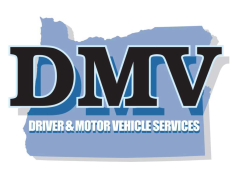
A. Keep your vehicle equipment in safe operating condition.
B. Maintain liability insurance as long as you drive.
C. Take a breath, blood or urine test if arrested for driving under the influence.
C. Take a breath, blood or urine test if arrested for driving under the influence.
Class C Driver Manual - Impaired Driving (Page 60)
Sample Question #4
A double solid yellow line means: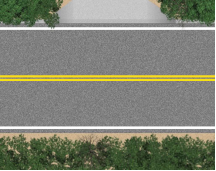
A. You may turn across the line to enter or exit a roadway.
B. You may cross over the lines to pass slower traffic on the right.
C. You may not turn across the line to enter or exit a roadway.
A. You may turn across the line to enter or exit a roadway.
Class C Driver Manual - Lane Travel – Pavement Markings (Page 17)
Sample Question #5
If using your high beams, you must dim your lights when oncoming traffic is within:
A. 500 feet.
B. 450 feet.
C. 400 feet.
A. 500 feet.
Class C Driver Manual - Safe and Responsible Driving – Hazardous Conditions– Using Lights (Page 55)
Sample Question #6
When approaching a public transit bus from behind, when must you yield for the bus to re-enter traffic?
approaching a public transit bus from behind, when must you yield for the bus to re-enter traffic?
A. If the bus has turned on its hazard lights.
B. Only when the bus doors are open.
C. When the bus has its turn signal and flashing yield sign on.
C. When the bus has its turn signal and flashing yield sign on.
Class C Driver Manual - School, Church or Worker and Public Transit Buses – Public Transit Buses (Page 43)
Sample Question #7
A safe following distance is defined as:
safe following distance is defined as:
A. 2 – 4 seconds.
B. No more than 2 seconds.
C. At least 5 seconds.
Sample Question #8
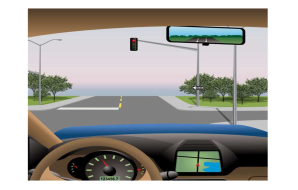 You are on a two-way street, stopped at an intersection. Can you legally turn left on a red light into a one-way street?
You are on a two-way street, stopped at an intersection. Can you legally turn left on a red light into a one-way street?
A. No. You must wait for the green light.
B. Yes, after yielding to other traffic and pedestrians.
C. Only if there is a green arrow with the red light.
B. Yes, after yielding to other traffic and pedestrians.
Class C Driver Manual - Turns and Intersections - Turns (Page 31)
Sample Question #9
 When passing bicyclists at speeds greater than 35 mph:
When passing bicyclists at speeds greater than 35 mph:
A. Leave enough distance to prevent contact with the bicyclist if they were to fall.
B. Drive faster so you can get past them quicker.
C. Lightly honk your horn so they will give you more room to pass.
A. Leave enough distance to prevent contact with the bicyclist if they were to fall.
Class C Driver Manual - Sharing the Road – Bicycles (Page 39)
Sample Question #10
 As a driver, you must stop for a pedestrian(s) at an intersection:
As a driver, you must stop for a pedestrian(s) at an intersection:
A. Only if the pedestrian is in a marked (painted) crosswalk.
B. Only if the pedestrian is on the other side of a safety island.
C. If the pedestrian is in a marked or unmarked crosswalk.
C. If the pedestrian is in a marked or unmarked crosswalk.
Class C Driver Manual - Sharing the Road - Pedestrians (Page 36)
Sample Question #11
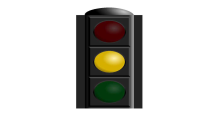 You are approaching an intersection with a traffic signal and the light changes from green to yellow. You should:
You are approaching an intersection with a traffic signal and the light changes from green to yellow. You should:
A. Slow down and continue through the intersection.
B. Stop before entering the intersection unless you are too close to stop safely.
C. Stop immediately.
B. Stop before entering the intersection unless you are too close to stop safely.
Class C Driver Manual - Signs and Traffic Signals - Traffic Signals (Page 13)
Sample Question #12
 When going uphill on an ice-covered road:
When going uphill on an ice-covered road:
A. Speed up to get to the top faster.
B. Use just enough power to keep moving.
C. Use the brakes to slow down constantly.
B. Use just enough power to keep moving.
Class C Driver Manual - Safe and Responsible Driving – Hazardous Conditions – Snow and Ice (Page 57)
Sample Question #13
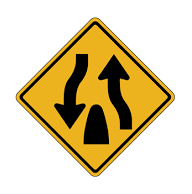
This sign means:
A. Keep Right.
B. Lane Reduction.
C. Divided Highway Ends.
Sample Question #14
 If you are unsure if school is in session, you should:
If you are unsure if school is in session, you should:
A. Slow down to 20 mph.
B. Stop for pedestrians.
C. Continue traveling the designated speed limit for non-school days.
Sample Question #15
 A blind spot:
A blind spot:
A. Is not necessary to check when making lane changes to the left.
B. Can be seen using your right side view mirror.
C. Is the area around your vehicle that you cannot see from your rear or side view mirrors.
C. Is the area around your vehicle that you cannot see from your rear or side view mirrors.
Class C Driver Manual - Lane Travel – Changing Lanes (Page 24)
Sample Question #16
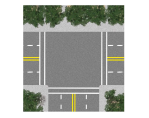 Who has the right-of-way at a “T” intersection with no signs or signals?
Who has the right-of-way at a “T” intersection with no signs or signals?
A. Traffic on the through road.
B. All traffic must stop and the driver on the right has the right-of-way.
C. Traffic on the road that ends at the “T” intersection.
A. Traffic on the through road.
Class C Driver Manual - Turns and Intersections - Intersections (Page 33)
Sample Question #17
 How does Oregon law restrict the use of a mobile electronic device for drivers under the age of 18 while operating a motor vehicle?
How does Oregon law restrict the use of a mobile electronic device for drivers under the age of 18 while operating a motor vehicle?
A. Drivers can read text messages but are not allowed to respond.
B. Drivers must use a hands-free accessory to use a mobile electronic device.
C. Drivers cannot use a mobile electronic device when operating a vehicle.
C. Drivers cannot use a mobile electronic device when operating a vehicle.
Class C Driver Manual - Safe and Responsible Driving – Dangerous Driving Behaviors – Distracted Driving (Page 58)
Sample Question #18
 Weaving through traffic can:
Weaving through traffic can:
A. Get you where you want to go faster.
B. Take longer to get to your destination.
C. Increase the risk of a crash.
C. Increase the risk of a crash.
Class C Driver Manual - Lane Travel – Freeway Driving – Entering a Freeway (Page 27)
Sample Question #19
 In order to safely back up your vehicle, you should:
In order to safely back up your vehicle, you should:
A. Turn your body and head both directions and look out through the rear window.
B. Rely on your rearview mirror and backup camera only.
C. Get out of your vehicle to check for children and animals before backing.
A. Turn your body and head both directions and look out through the rear window.
Class C Driver Manual - Lane Travel – Maintaining a Space Cushion - Backing Up (Page 23)
Sample Question #20
 When parking uphill against a curb:
When parking uphill against a curb:
A. Turn your front wheels toward the curb.
B. Turn your front wheels toward the travel lane.
C. Keep your front wheels straight.
B. Turn your front wheels toward the travel lane.
Class C Driver Manual - Parking and Stopping- Parking on Hills (Page 50)